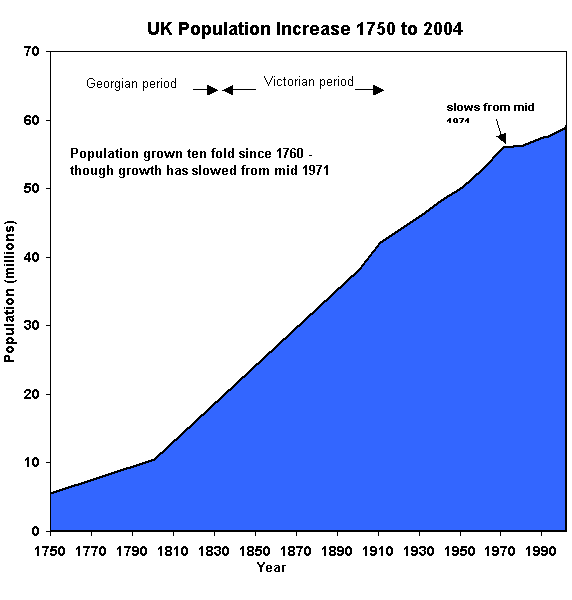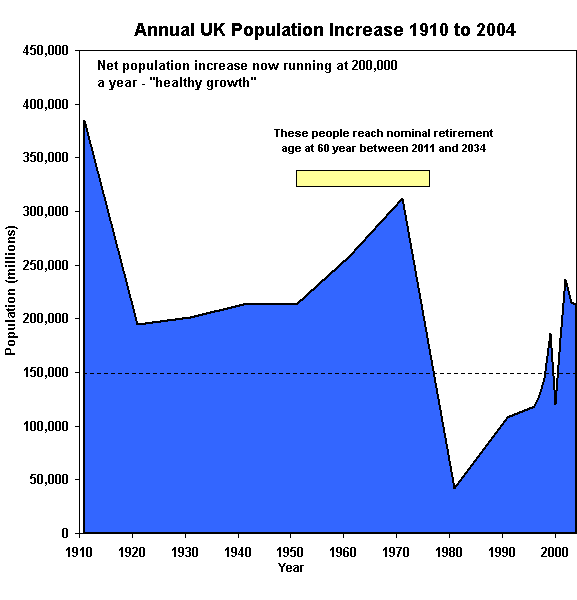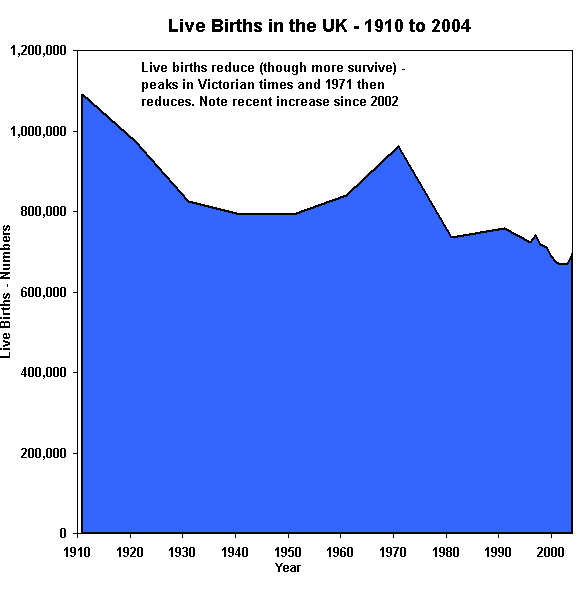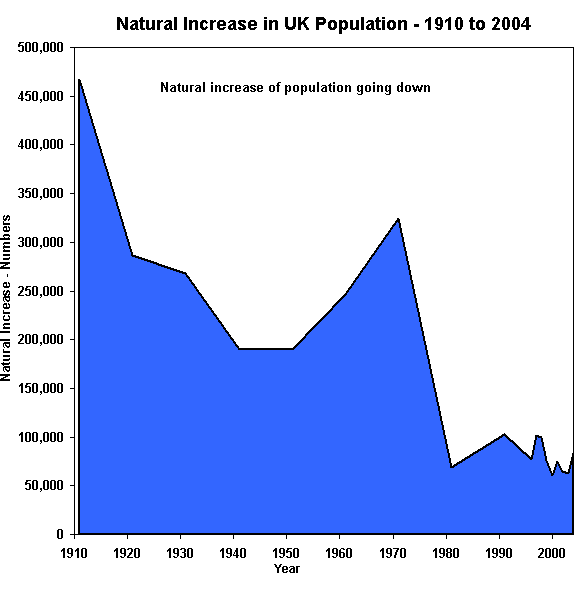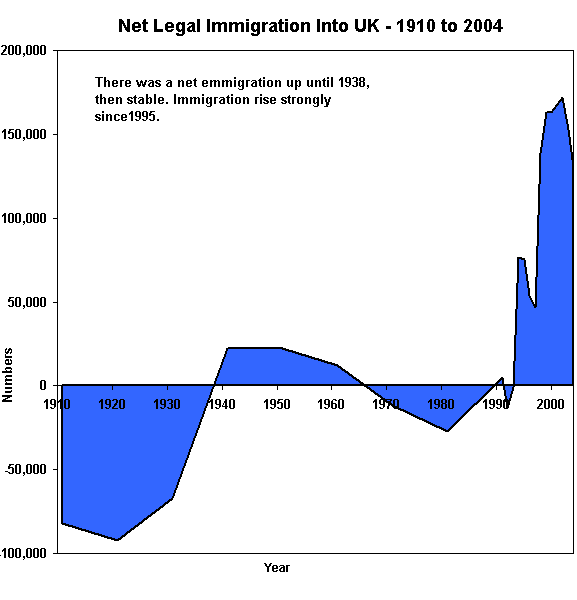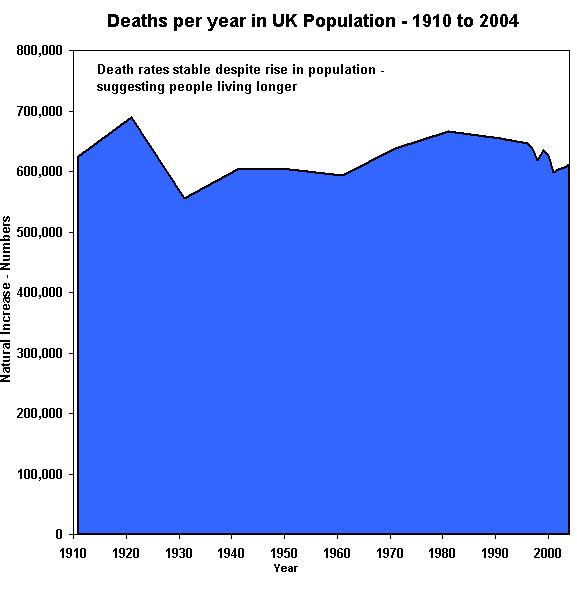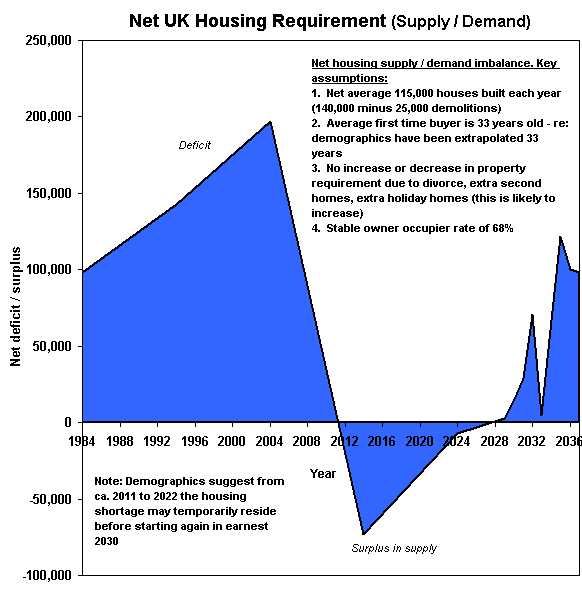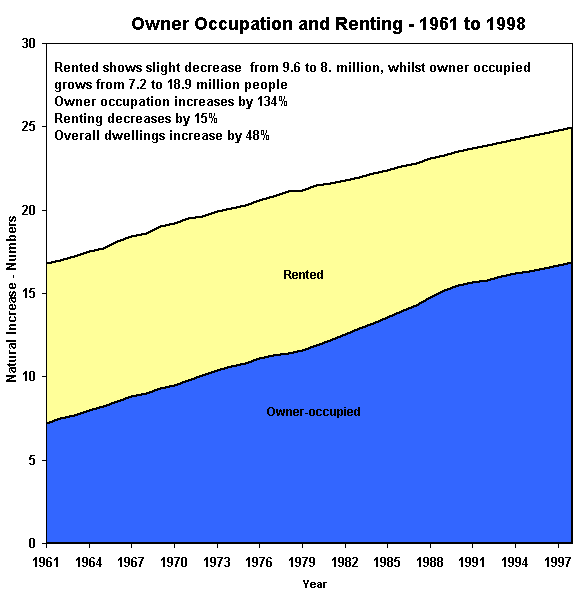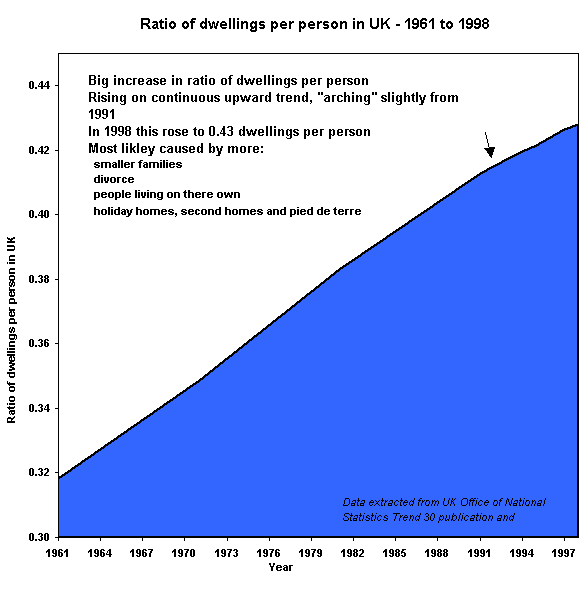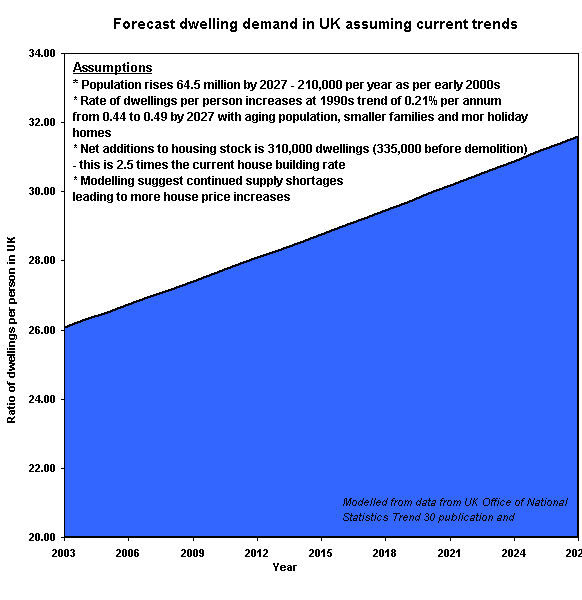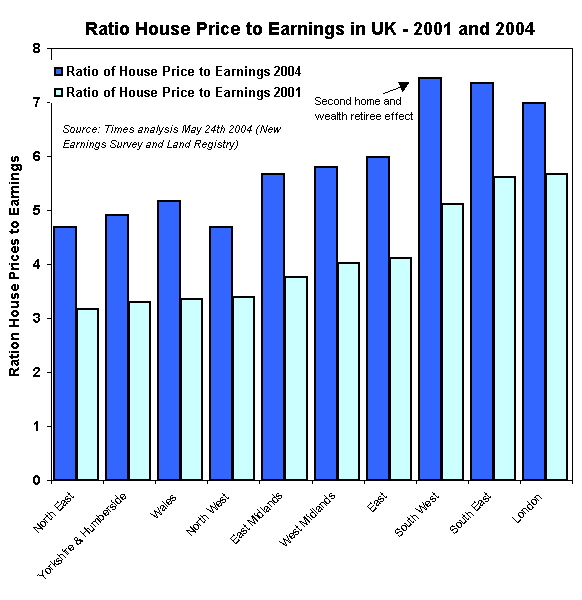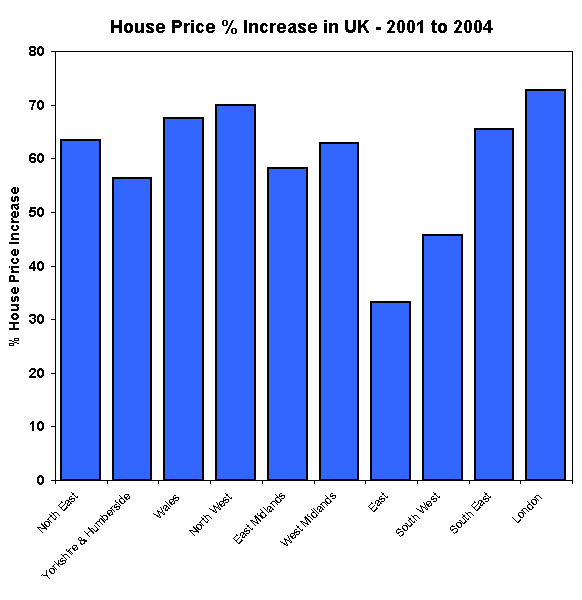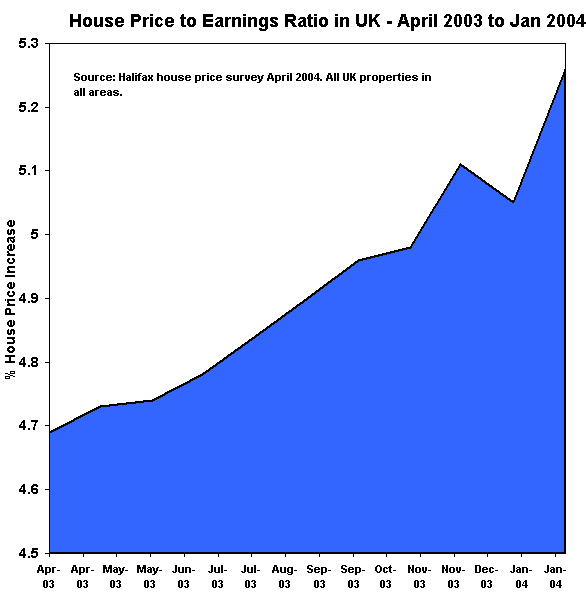5: UK Demographic and Housing Trends - impact on property investment and supply/demand
05-23-2004
Summary: PropertyInvesting.Net has analysed UK demographic data taken from the UK Office of National Statistics. The UK population has grown nearly 20% since 1950. There was an estimated 59,200,000 people living in the UK in mid-2002 - the population is rising at about 200,000 per year. The latest (mid-2002 based) official population projection suggests a population of some 64.8 million by 2031.
News from May 13th 2004 reported the birthrate in England and Wales rose 4.3% from 2002 to 621,469 live births in 2003. This raises the total fertility rate (TFR) based on 2003 patterns of fertility by age, from 1.65 (2002) to 1.73 (2003), fairly health in European terms and enough along with net immigration to maintain a propulation growth of some 200,000 - 250,000 a year.
Of particular note in the below analysis is the largest growth in population after 1920 was between 1951 and 1972. Assuming these people retire at aged 60, they will start retirng in 2011 and finish retiring in 2031. This analysis is important for predicting "baby-boomer" retirement housing provision.
Immigration has been fairly constant over the years - recently increasing to some 130,000 per year (legal immigrates, including asylum seekers).
House Building: There were less homes built in the last five years than at any time in the last 50 years. Total homes being built are around 140,000 per year, whilst homes demolished are 25,000 per year (net 115,000 additions). The number of homes required is expanding because the amount of people living on there own is increasing - due to divorce, widowing, and increasing numbers of holiday homes and people keeping more than one home. There is a supply / demand imbalance that would only go away if at the minimum another 100,000 homes were built each year even ignoring people aspiration to own more than one home and the trend for people to live in smaller households. This increase in building is not likely for at least another 5-10 years due to lengthy planning provision. According to NHBC, in Q1 2004, UK home completions dropped from 38,670 to 33,909 from the corresponding period in 2003, a 13% decrease. For the property investor, this analysis suggest continued under supply and fairly strong demand which will at least support residential property prices, if not lead to general increases is prices in areas of most demographic strain (e.g. London, SE England, Cornwall, Devon, southern England). The UK has high levels of owner occupation - a most people aspire to be owner occupiers. Some believe this is their right as a UK citizen. Historically this is a recent phenomena - in 1914 owner occupation was 14% - this increase to 68% by 1999. It is likely that unless home building increases dramatically, prices will keep going up as long as interest rates stay low (below say 5.5%) and the economy and employment stay healthy.
Impact of Demographics on Property Investing: The demographics suggest first time buyer numbers should be starting to peak around 2004 since the peak in population increase was 1971 - these people are now 33 years old - expect a slight reduction in potential first time buyers over the next five years because of this demographic change. There numbers may dwindle for other reasons such as affordablity constraints - this trend was noticed in mid 2003 through 2004.
A. Baby-boomer strategy: From 2011 to 2030 there will be a large increase in over 60s retiring. Many of these people will want to settle in southern coastal areas of the UK (e.g. Cornwall, Devon, Kent, Dorset, Sussex, South Wales, East Anglia) and trendy market towns and country locations (Cotswolds, Wealden, Cumbria, Dales). Expect holiday and retirement centres to become even more popular as these people aspire to live in low maintenance houses and apartments, preferably with sea or country views though close to good amenities. Do not expect mass migration out of the UK since most retirees like to be close to family and friends - the more wealthy retirees may have a second home "in the sun" but will still retain a home base in the UK.
B. First time buyer strategy: From mid 1971 to 1980 there was a large decrease in births and immigration hence the population increase reduced dramatically from 330,000 per year to 40,000 per year. After 1980, this annual increase rose to its current level of increase of around 250,000 people per year (of which about a half is net immigration). Assuming an average age of a first time buyers is 33, one could expect a lull in such buyers between say 2005 and 2018. If these buyers have delayed purchasing their first property until say 36, then this would delay this lull period until 2008.
Adopting these two demographic trends, one should shift ones investment portfolio away from the first time buyer market to retirement market (over 60s) and trading up (over 38s) around now. Prices for terraces houses (trade-ups) have risen the strongest in 2004 and first time buyers are reducing in 2004 suggesting this trend is beginning (between 2000-2003 the biggest price increases were in flats). In addition, most of the net wealth is now with the over 45 year olds, so these people will have more to spend on property - both trading up or downsizing to luxury apartments and smaller houses and positioning themselves for retirement.
Overall Deficit of Housing and Demographics: PropertyInvesting.Net has prepared a simplistic forecast of the supply/demand imbalance in the UK using the following key assumptions:
- Net average 115,000 houses built each year (140,000 minus 25,000 demolitions)
- Average first time buyer is 33 years old - re: the demographic trends have been extrapolated 33 years
- No increase or decrease in property requirement due to divorce, extra second homes, extra holiday homes (this requirement is most likely to increase as general wealth increases)
- Stable owner occupier rate of 68%
The key insight is the large supply/demand imbalence up until 2004, which might partly explain the extending period of property price increase seen in the UK from 1996 to 2004. However, given the building of a net 115,000 units a year, this under-supply might reduce steeply by 2011 until 2022 because of the drop in population increase after 1971. This would not necessarily imply a drop in prices - more a return to a closer balance between supply and demand. 50,000 properties could quite easily be taken up by an increase in second home or holiday home numbers from a population of say 25 million home-owners (e.g. an extra 0.2% of the home owning population per year for ten years purchasing another second home or pied-de-terre). It is also likely that the population of SE England / London will be far higher than the homes built in this region and people wanting to retire to the south - hence prices will continue to increase in the south. The population of SE England is forecast to rise by 1 million in the next 10-15 years, so one can see housing pressures will build up unless there is a big surge in home building in the region. Although there are plans for such preliminary plans home-buying in the Thames Corridor and Milton Keynes / Cambridge areas, there is quite some scepticism as to whether large numbers of homes will be built in the next ten years due to the environmental lobby, slow planning process and building skills shortages.
Owner Occupation: There has been a huge increase in owner occupation from 7.2 million in 1961 to 18.9 million dwellings in 1998 - a 134% increase. Rental dwellings have reduced 15% in the same time from 9.6 million to 8.2 million. Total dwellings have risen a hefty 48%. Clearly, though the population is increasing slightly, we are seem to need more dwellings. The ratio of dwellings to each UK person has rocketted from 0.32 in 1961 to 0.43 in 1998 - an increase of 34.6% in 37 years - more people are living on there own, 40% of people get divorced and there are more second homes, holiday homes and pied de terre. PropertyInvesting.Net's research and analysis suggests that if the 1990s trend in amount of dwellings per individual continue, then assuming a 2020 population of 65 million, the new ratio will be 47.5% which will require a net 270,000 new homes to be built every year from 1998 onwards. The cuurent rate of some 150,000 additions in aonly half the amount required to keep up with the expending population and smaller households. No specific mention of the dramatically reducing household sizes has been made in the recent Barker Report. To provide the correct amount of housing for the populations wishes and to prevent radily escalating house prices and a greater housing shortage, it would seem prudent to ramp up house building of small affordable units now, before a housing crisis hits us. The social consequences of younger people with less wealth having to stay at home with their parents and people sharing their homes is something that needs considering. In addition, the economic impact of the inflexibility of workers in the labour market is another consideration. For the property investor, it suggests a significant opportunity to invest in social housing and help thesupply side of the equation.
What does this mean for the investor? For the property investor, the above analysis supports the view that good quality retirement homes in the south of England will be a solid future investment market. Options include:
- Cornwall, Devon, Dorset
- Pied-a-terre in Bow/Limehouse, East London
- Any quality 2 double bedrooms flat along the south coast bought at market good value (e.g. Portsmouth, Hastings, Kingsbridge)
- High quality market towns and country location in the south (e.g. Stroud, Chichester)
Properties close to good amenities, secure, low maintenance, close to cafes, with views and secure parking are much preferred.
